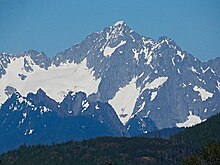Eldorado Peak
Climbing
Eldorado appears quite different depending on the side one is viewing. On the west side the peak is a steep face made of vertical slabs and small gullies. From the east side the mountain is a small rocky outcropping surrounded by ice. The south face is a triangular face flanked by long ridgelines. The most popular and easiest climbing route is from the south and east, via the Inspiration Glacier and a moderately steep snow ridge. Eldorado is a popular climbing destination due to easy access, being one of the 100 highest peaks in Washington, and superb mountain views. Most climbers will take two days to complete the trip, though the climb can be completed in one long day.
Routes

- West Arete rock route up the west face class 5.8 Grade IV
- East ridge Glacier travel to steep snow ascent class 2
- Northeast ridge ice and snow ascent Class AI2
- Northwest Ice Corridor ice and rock class M3 to M4
Geology
Eldorado is very simple geologically when compared to other mountains in the Cascades, with only one major rock type, Cretaceous orthogneiss, more specifically biotite granodiorite. Only the lowest flanks are made of different rock types, mostly heterogeneous metamorphic rock. There are only two normal faults: one on the east flank, the other on the west flank.
Climate

Eldorado Peak is located in the marine west coast climate zone of western North America. Most weather fronts originate in the Pacific Ocean, and travel northeast toward the Cascade Mountains. As fronts approach the North Cascades, they are forced upward by the peaks of the Cascade Range (Orographic lift), causing them to drop their moisture in the form of rain or snowfall onto the Cascades. As a result, the west side of the North Cascades experiences high precipitation, especially during the winter months in the form of snowfall. Due to its temperate climate and proximity to the Pacific Ocean, areas west of the Cascade Crest very rarely experience temperatures below 0 °F (−18 °C) or above 80 °F (27 °C). During winter months, weather is usually cloudy, but, due to high pressure systems over the Pacific Ocean that intensify during summer months, there is often little or no cloud cover during the summer. Because of maritime influence, snow tends to be wet and heavy, resulting in high avalanche danger.
See also
References
- ^ "Eldorado Peak, Washington". Peakbagger.com.
- ^ "Eldorado Peak". NGS Data Sheet. National Geodetic Survey, National Oceanic and Atmospheric Administration, United States Department of Commerce.
- ^ "Mountaineer Annual, 1930-39". Alpenglow Ski Mountaineering History Project.
- ^ "Eldorado Peak". Geographic Names Information System. United States Geological Survey, United States Department of the Interior.
- ^ "Eldorado Peak : Climbing, Hiking & Mountaineering : SummitPost".
- ^ "CalTopo - Backcountry Mapping Evolved".
- ^ "CalTopo - Backcountry Mapping Evolved".
- ^ "DNR Viewer Application". Archived from the original on 2015-07-04. Retrieved 2015-07-03.
- ^ Beckey, Fred W. Cascade Alpine Guide, Climbing and High Routes. Seattle, WA: Mountaineers Books, 2008.
External links
 Media related to Eldorado Peak at Wikimedia Commons
Media related to Eldorado Peak at Wikimedia Commons- "Eldorado Peak". SummitPost.org.
- Breit, Tom. "Eldorado Peak". Peakware.com. Archived from the original on 2016-03-04.